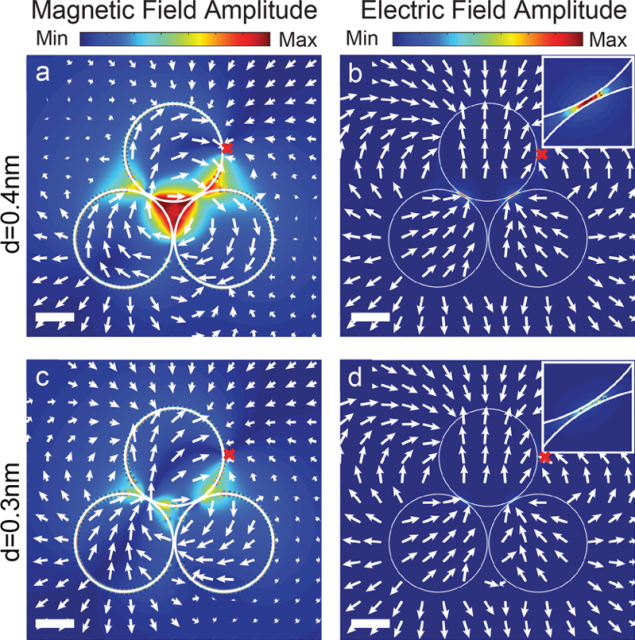The classical behaviour of the dark modes of silver nanotrimers
Nanoparticles of certain metals, like gold or silver, have attracted substantial interest in recent years owing to their ability to support localized surface plasmon resonances (collective oscillations of conduction electrons). These plasmonic excitations allow manipulation of light at the nanoscale and have enabled technological advances ranging from improved catalytic and photovoltaic cell efficiencies to sensitive molecular detectors, medical therapeutics, nanoscale lasers, spasers (the nanoplasmonic counterpart of a laser, but it ideally does not emit photons. It is analogous to the conventional laser, but in a spaser photons are replaced by surface plasmons and the resonant cavity is replaced by a nanoparticle, which supports the plasmonic modes), and modulators.

While most plasmonic systems have been designed using a classical electrodynamic framework, several recent studies have shown that quantum effects can significantly modify the electromagnetic response. For example, quantum phenomena such as tunnelling – an effect in which electrons are able to tunnel through a narrow potential barrier that would constitute a forbidden region if the electrons were treated as classical particles-, and size-dependent confinement effects have been observed. These phenomena have led to relative blueshifts and resonance quenching, as well as the emergence of new tunnelling modes. These results not only provide an important design consideration for optical nanoantennas, but may also enable ultrafine sensors and new molecular electronic devices.
To date, nearly all studies of quantum plasmonic systems have focused on one- or two-particle systems. Nevertheless, higher-order modes such as magnetic ones are of paramount importance in plasmonic materials and devices. The so-called dark modes – plasmonic resonances that cannot be directly excited by light almost parallel to the optical axis of the system owing to their lack of a net dipole moment – are also of interest in the development of ultrasensitive molecular detectors. The influence of quantum effects on these modes remains unexplored, largely due to the challenges associated with fabricating subnanometre features in complex nanoparticle geometries.
Now a team of researchers from Stanford University, the SLAC National Accelerator Laboratory and CFM & DIPC, including Aitzol Garcia-Etxarri, Garikoitz Aguirregabiria, Ruben Esteban, and Javier Aizpurua, has investigated1 the electric, magnetic, and dark plasmonic modes as they transition from the classical to quantum regime.
The researchers have focused on nanoparticle silver trimers as one of the most basic plasmonic metamolecules supporting a rich variety of resonances of different fundamental character. To access the quantum regime, they used a combination of scanning transmission electron microscopy (STEM) and electron energy-loss spectroscopy (EELS). The focused electron beam was used both to image and manipulate the interparticle separation of self-assembled trimers. Concurrently, EELS allowed direct probing of the plasmonic response.

Correlating plasmonic spectra with trimer geometry, the physicists were able to discover prominent quantum influences on the electric and magnetic modes of trimers at the smallest separation distances, even though a purely classical behaviour was found for the radially symmetric dark modes.
Thus, classical electrodynamics is insufficient for certain important cases (i.e., electric bonding and magnetic modes) in which quantum phenomena appear. There is a strong indication of the existence of electron tunnelling between particles.
Therefore, the consideration of quantum features will play an important role in the design of future multiparticle metamolecules with sub-nanometre gaps. These results support new interdisciplinary exploration bridging molecular electronics, nonlinear optics, and plasmonics.
Author: César Tomé López is a science writer and the editor of Mapping Ignorance
References
- Jonathan A. Scholl, Aitzol Garcia-Etxarri, Garikoitz Aguirregabiria, Ruben Esteban, Tarun C. Narayan, Ai Leen Koh, Javier Aizpurua, and Jennifer A. Dionne (2016) Evolution of Plasmonic Metamolecule Modes in the Quantum Tunneling Regime ACS Nano doi: 10.1021/acsnano.5b06738 ↩